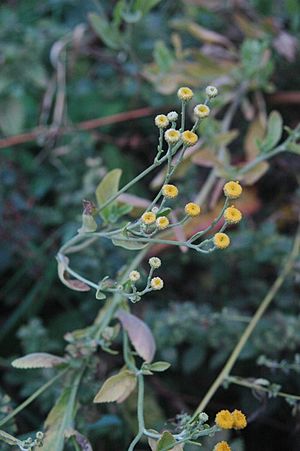Tanacetum balsamita facts for kids
Quick facts for kids Tanacetum balsamita |
|
|---|---|
 |
|
| Scientific classification | |
| Genus: |
Tanacetum
|
| Species: |
balsamita
|
| Synonyms | |
|
|
Tanacetum balsamita, often called costmary, is a special plant. It's a type of herb that grows year after year. People also know it by other names like alecost, balsam herb, bible leaf, or mint geranium.
Contents
What Costmary Looks Like
Costmary is a plant that comes back every year. It has oval-shaped leaves with jagged edges. This plant can grow quite tall, up to about 2 meters (or 6.5 feet) high! In the summer, you can see its small, yellow, round flowers. These flowers often grow in groups, looking like little buttons.
Where the Name "Costmary" Comes From
The name 'costmary' has an interesting history. It comes from the words 'costus of Saint Mary'. In many languages, this plant is linked to the Virgin Mary. This might be because it was sometimes used to help with women's health issues a long time ago.
The History and Spread of Costmary
Costmary likely first grew in the Mediterranean region. This is the area around the Mediterranean Sea. It's not totally clear if the "balsamita" plant mentioned in ancient texts from 70 AD is the same as our costmary. However, we know it was first written about in a plant list in 812.
For many centuries, especially during the Middle Ages, costmary was very popular. People grew it in their herb gardens for its medicinal uses. It was widely used until the late 1800s and early 1900s. Today, you don't see it as much in Europe. But it's still commonly used in southwest Asia. In medieval times, people even used its leaves as bookmarks in their Bibles!
Traditional Uses of Costmary
Costmary has been known for a very long time. Ancient books about plants, called herbals, mention it. It was a common plant in the fancy "knot gardens" of the Elizabethan era.
In the 1700s, people thought costmary could help with many things. They believed it could act as a laxative, help with stomach problems, and tighten tissues. It was also suggested for sadness, nervousness, and even certain stomach illnesses.
A famous herbalist from the 1600s, Nicholas Culpeper, wrote about costmary. He believed it could help the body in many ways. He said it could make you urinate more and soften certain parts of the body. He also thought it helped clean the body and prevent decay. Culpeper suggested it was good for stomach issues and strengthening organs like the liver. He even mentioned that its seeds were given to children to help with worms. The plant was also used to make a special salve (a healing ointment) for old sores.
Images for kids



